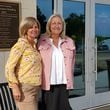As master sommelier Catherine Fallis opened the annual International Alsace Varietals Festival with a discussion and tasting of Cremant d'Alsace, she raised a glass of the rose bubbly from Pierre Sparr and noted: "The two fastest growing wine trends in the United States are sparkling wine and rose. Here we have both in one glass."
The festival, held at the Mendocino County Fairgrounds on Feb. 25 in Booneville, celebrates not only the varietal wines of Alsace -- notably riesling, pinot gris, pinot blanc and gewurztraminer -- but also wines from the New World made from the same grapes.
The backdrop is California's remote Anderson Valley, close to the Mendocino Coast but far from any other notable landmark.
The rolling hills of the Anderson Valley are the land of redwoods, postcard mountain meadows, live oaks, grazing sheep and, not least, some of the most coveted vineyards in California.
Pinot noir is the money grape in the valley. Its pinots, richly layered and beautifully structured, thrive off the cool coastal influence that preserves acidity and keeps the wines fresh and inviting.
The same conditions are ideal for the aromatic white grape varieties of Alsace, a charming but remote region tucked between the Vosges Mountains and Rhine River in northeast France. Other than the Finger Lakes region of New York, no other winegrowing region in the U.S. has a greater commitment to Alsace varietal wines than the Anderson Valley.
The Anderson Valley Winegrowers Association sponsors the Alsace festival as part of its broader effort to promote the viticultural bounty of the region. To its credit, however, the valley's winegrowers don't exploit the festival as a weekendlong infomercial for the valley.
This year's program of three seminars threw a spotlight on the sparkling wines of Alsace, the success of Alsace grapes in New Zealand and the dry riesling boom in northern Michigan.
Each delivered its own unique takeaway.
At the opening seminar on Cremant d'Alsace, four different bubblies were poured. Cremant d'Alsace is made in the traditional Champagne method, meaning the second fermentation, the one that creates the bubbles, occurs in the bottle as opposed to a large stainless steel tank (in the manner of Prosecco).
Although six different grape varieties are permitted (pinot blanc, pinot auxerrois, pinot gris, pinot noir, riesling and chardonnay), the backbone of Cremant d'Alsace seems to be pinot blanc, pinot noir and chardonnay, the chardonnay giving the wines a little more richness and complexity than other cremants of France.
The quality for the price (most good Cremant d'Alsace range in price from $20 to $28) represents tremendous value and makes these wines an excellent alternative to more expensive Champagne. The wines presented were the Albert Mann Extra Brut 2013, Charles Baur Brut Collection, Willm Blanc de Noirs (100 percent pinot noir) and the Pierre Sparr Cremant d'Alsace Rose (also 100 percent pinot noir).
The Albert Mann was the driest of the four, but my personal favorite was the Pierre Sparr Rose, which I found to be brighter and more complex, a good match for fish, white meats and spicy tapas. That said, all four were well above average and extremely attractive given the price points.
The New Zealand presentation was most interesting because it reinforced the sentiment that wine enthusiasts need to look past sauvignon blanc and explore the other exceptional wines being produced by the Kiwis. Three wines were presented: a dry riesling from Villa Maria in Marlborough, a pinot gris from Ostler Lakeside in the relatively new Waitaki Valley appellation and a dry gewurztraminer from Lawson's in Marlborough.
Much like the renowned sauvignon blancs of New Zealand, the Alsace varietals all show lifted levels of acidity, which makes the wines both fresh and agreeable with food. The Riesling, from the 2011 vintage, was a complex mineral-driven riesling that would have done the Mosel proud. Both the Pinot Gris and Gewurztraminer delivered extraordinary richness, complex aromatics and mouthwatering acidity that is typical of Alsace varietals when they are well-made.
The Michigan rieslings, sourced from the Old Mission Peninsula and Leelanau Peninsula, were a revelation because it would seem northern Michigan is far too north, far too cold and far too susceptible to disastrous weather patterns to produce world-class wines.
Dr. Charles Edson, whose Bel Lago Winery on the Leelanau Peninsula has been in business for 30 years, explained that the proximity to Lake Michigan was the key factor in the success of viticulture in the region. "It's the lake effect," he said. "It protects us in winter, extends autumn and keeps us warm."
That doesn't mean there aren't other challenges. "We typically harvest in late October, early November," he said. "Sometimes we harvest riesling in the snow!"
The Michigan rieslings don't have to make any apologies, though. All three demonstrated the potential of Michigan riesling. The wines were stylish, well-made and every bit at home on the same stage with the best Alsace varietals the Anderson Valley had to offer.
About the Author

/cloudfront-us-east-1.images.arcpublishing.com/ajc/P7DYBH6TO7FEKG4SUXQQKADRXE.jpg)



